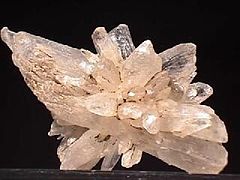- Mirabilite
-
Mirabilite 
General Category Sulfate minerals Chemical formula Na2SO4·10H2O Strunz classification 07.CD.10 Identification Molar mass 322.2 Color Colorless, white, yellowish white, greenish white Crystal habit Granular or well-formed coarse sized crystals Crystal system Monoclinic-prismatic 2/m, Space group P21/a Twinning Interpenetration twinning on {001}; also on {100} Cleavage {100} perfect, {001} poor, {010} poor Fracture Conchoidal Mohs scale hardness 1.5–2 Luster Vitreous Streak White Diaphaneity Transparent to translucent to opaque Specific gravity 1.49 Optical properties Biaxial (–), 2V=75.93° Refractive index nα = 1.396, nβ = 1.4103, nγ = 1.419 Birefringence δ = 0.023 Pleochroism none Other characteristics Not radioactive, non-fluorescent References [1][2] Mirabilite, also known as Glauber's salt, is a hydrous sodium sulfate mineral with the chemical formula Na2SO4·10H2O. It is a vitreous, colorless to white monoclinic mineral which forms as an evaporite from sodium sulfate bearing brines. It is found around saline springs and along saline playa lakes. Associated minerals include gypsum, halite, thenardite, trona, glauberite, and epsomite.
Mirabilite is unstable and quickly dehydrates in dry air, the prismatic crystals turning into a white powder, thenardite (Na2SO4). In turn, thenardite can also absorb water and converts to mirabilite.
Mirabilite is used as a purgative in the Traditional Chinese medicine; in Mandarin it is called máng xiāo. Its name is based on the phrase "Sal mirabilis" (Latin for "wonderful salt") used by Johann Rudolph Glauber when he inadvertently synthesized mirabilite.[2][3]
References
- ^ Mirabilite at Webmineral
- ^ a b Mirabilite at Mindat
- ^ Hill, James C. (1979). "Johann Glauber's discovery of sodium sulfate - Sal Mirabile Glauberi". Journal of Chemical Education 56 (9): 593. doi:10.1021/ed056p593.
External links
- Maricopa.edu
- American Mineralogist (1917)
- "Mirabilite as a tracer of past evolution of the Aral Sea"
Wikimedia Commons has media related to: This article about a specific sulfate mineral is a stub. You can help Wikipedia by expanding it.
